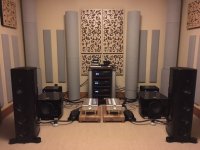- Thread Author
- #1
I wanted to start this thread to keep a running commentary on the integration of a pair of REL G1 Mk2 sub woofers I have purchased to integrate with my M3's. I don't want to turn the thread into a discussion on the merit of subs or why they are needed with mega buck speakers. The discussion of the process will likely be beneficial to many Sharks who have considered doing the same thing. First post: Very informative background reading from Jim Smith.
http://www.psaudio.com/article/subwoofery-trick-or-treat/
http://www.psaudio.com/article/38363/
http://www.psaudio.com/article/subwoofery-the-finale/
I've downloaded the RTA app for my iPad and have a small microphone on the way. This should be fun
More to come.
Eric
http://www.psaudio.com/article/subwoofery-trick-or-treat/
http://www.psaudio.com/article/38363/
http://www.psaudio.com/article/subwoofery-the-finale/
I've downloaded the RTA app for my iPad and have a small microphone on the way. This should be fun
More to come.
Eric

